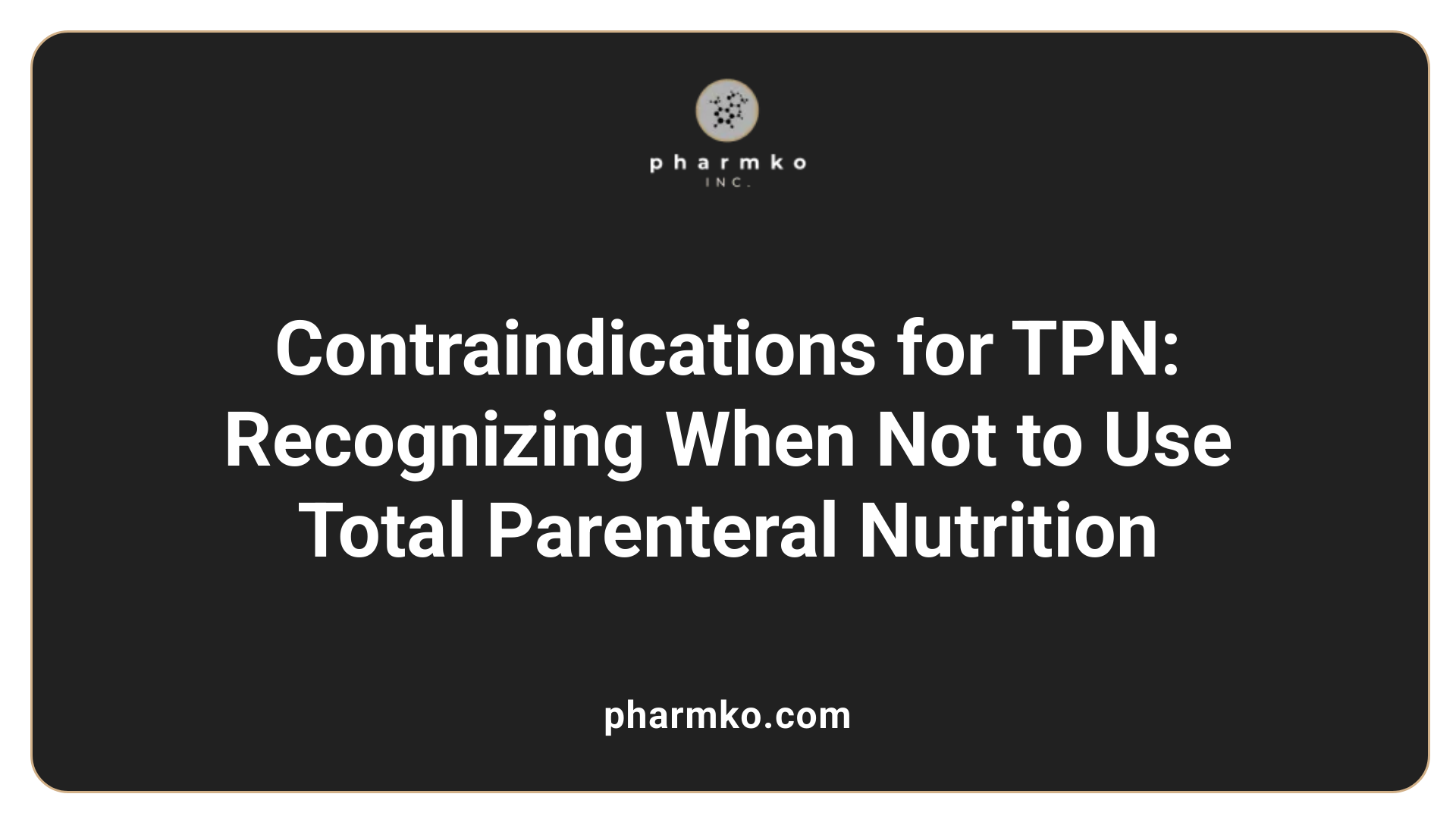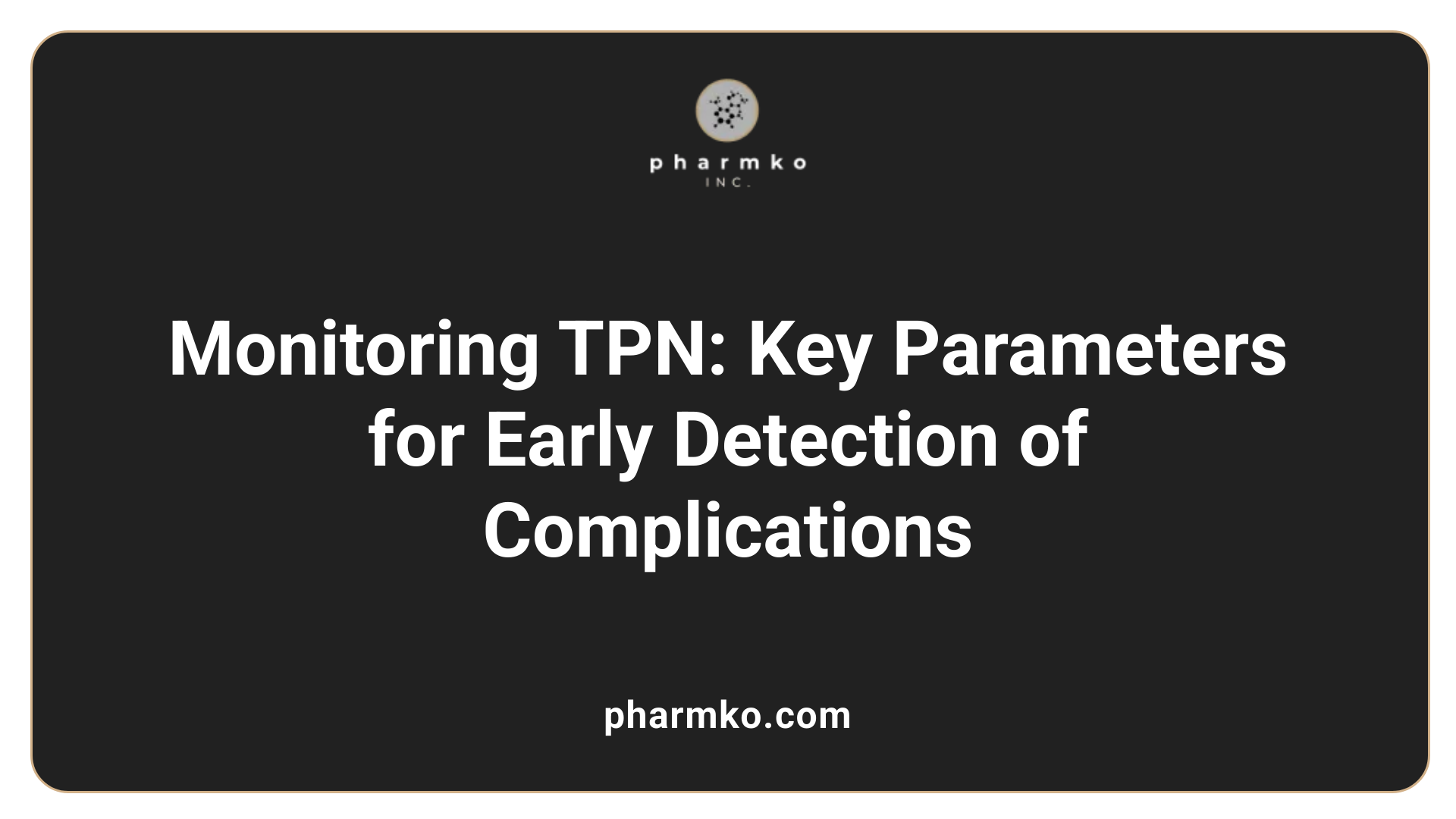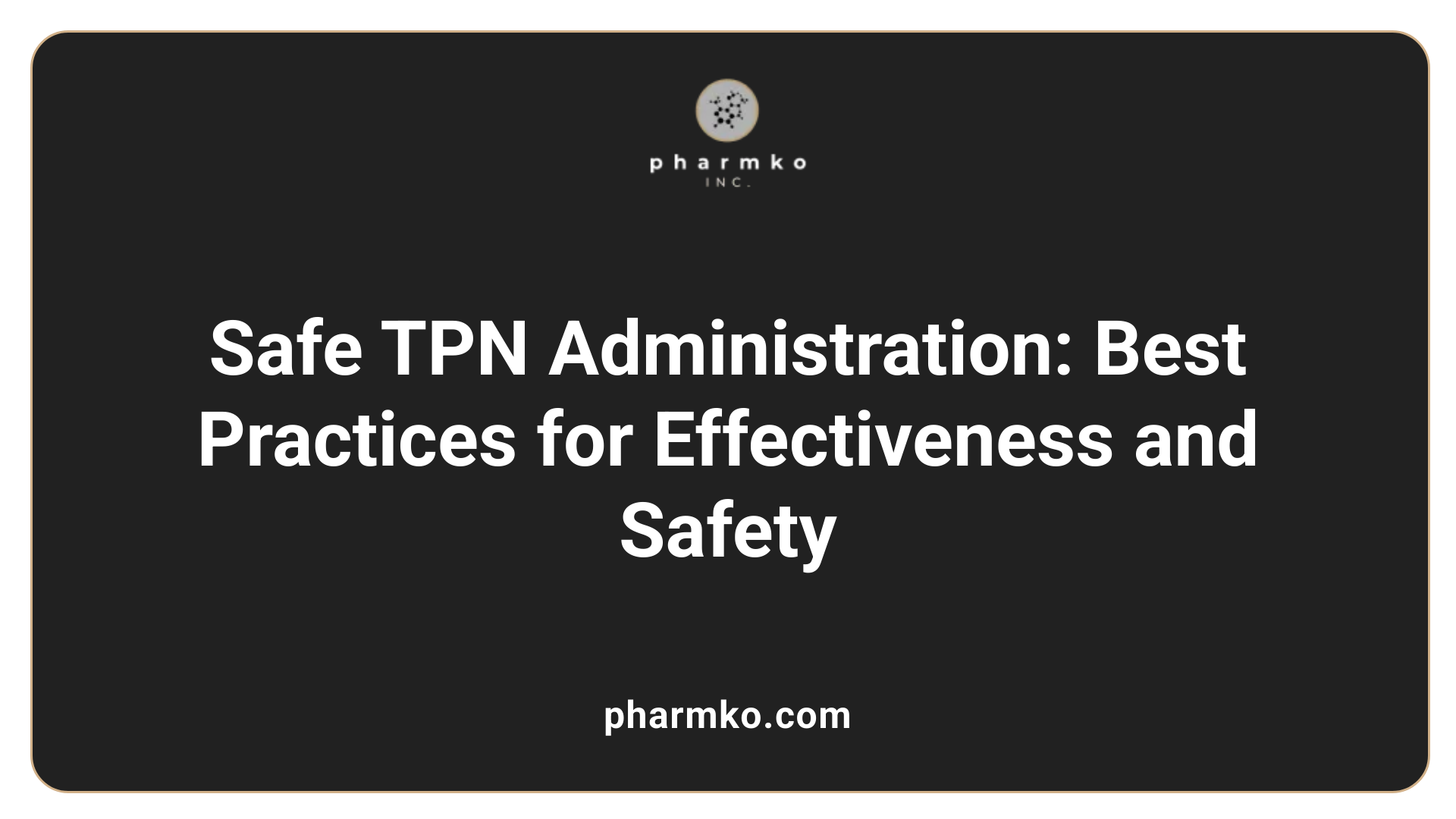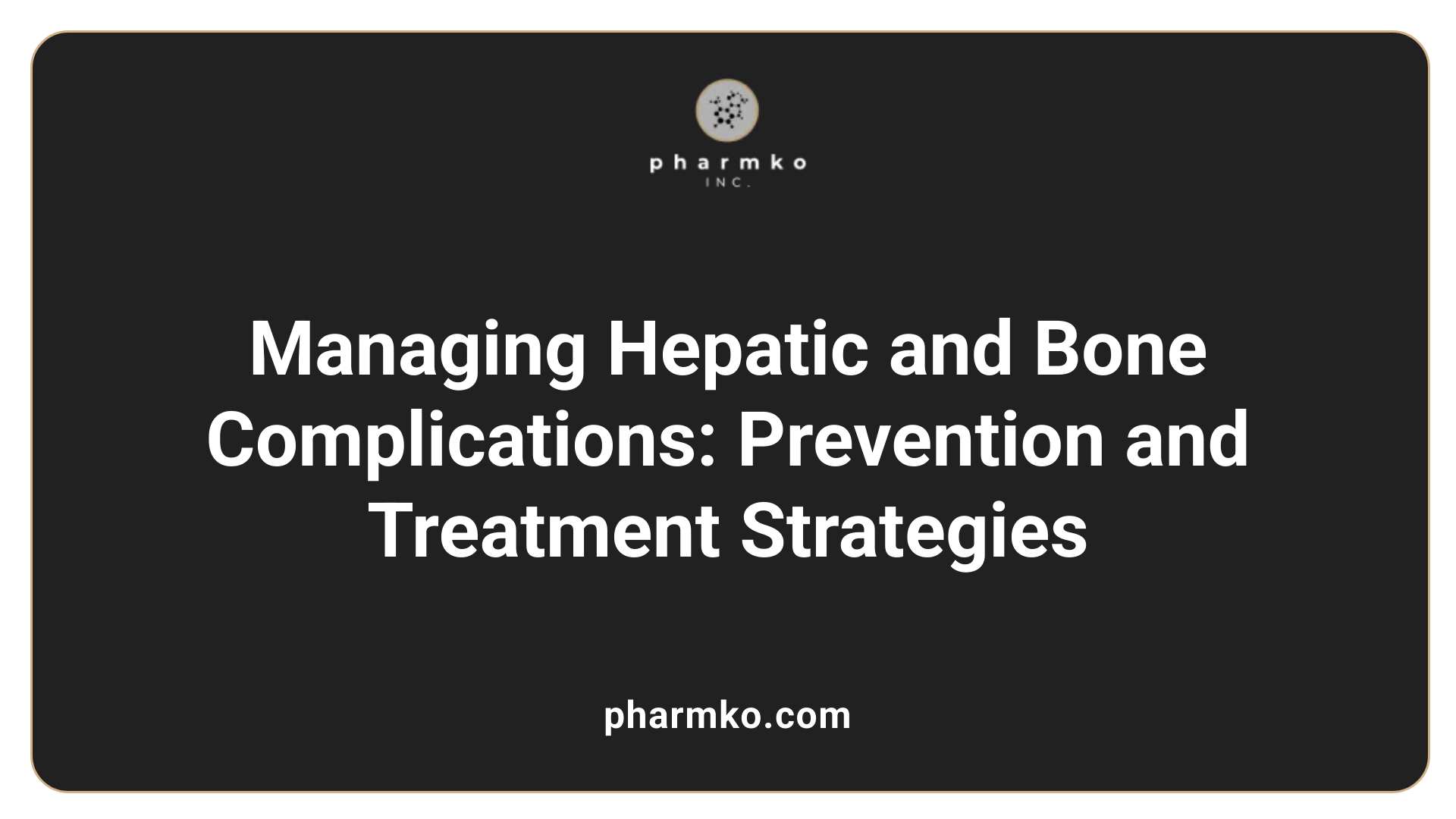How to Minimize Complications Associated with Long-Term TPN Use
Introduction to Long-Term Total Parenteral Nutrition
Total parenteral nutrition (TPN) is an essential intervention for patients with impaired gastrointestinal function, providing critical nutrients directly into the bloodstream. While lifesaving, long-term TPN carries a substantial risk of complications that need vigilant management. This article explores comprehensive strategies for preventing, detecting, and managing these challenges to improve patient outcomes.
Indications for Long-Term TPN and When It Becomes Necessary
 Total parenteral nutrition (TPN) is a crucial supportive therapy used in various clinical scenarios where the gastrointestinal (GI) tract cannot adequately perform its function of nutrient absorption and digestion. It provides essential nutrients directly into the bloodstream, bypassing the GI system entirely.
Total parenteral nutrition (TPN) is a crucial supportive therapy used in various clinical scenarios where the gastrointestinal (GI) tract cannot adequately perform its function of nutrient absorption and digestion. It provides essential nutrients directly into the bloodstream, bypassing the GI system entirely.
What are the indications for total parenteral nutrition (TPN)?
TPN becomes necessary under circumstances where enteral feeding is contraindicated or insufficient. Common indications include conditions such as chronic intestinal obstruction, severe malabsorption syndromes, and high-output gastrointestinal (GI) fistulas. It is also essential in managing post-operative leaks and small bowel obstructions that compromise the continuity or functional capacity of the digestive tract.
In addition, TPN is indicated in hypercatabolic states, such as severe trauma, burns, sepsis, and major surgeries, where the metabolic demands are significantly increased, but GI absorption cannot meet these needs. Extended periods of nil per os (NPO), often exceeding several days, also necessitate TPN to prevent malnutrition and support recovery.
Chronic intestinal obstruction
This condition involves a physical blockage in the small or large intestine, preventing normal passage of contents and nutrients. TPN provides vital nutrition when surgical or conservative management does not restore bowel function.
Severe malabsorption
Conditions like Crohn’s disease, extensive resection, or certain congenital anomalies impair nutrient absorption, leading to deficiencies and weight loss, thereby requiring TPN.
High-output GI fistulas
Fistulas that produce excessive intestinal secretions compromise nutrient absorption and can cause dehydration and electrolyte imbalances, making TPN a necessary adjunct.
Post-operative leaks
Leaks at surgical sites in the GI tract can result in contamination and loss of nutrients, necessitating TPN support until healing occurs.
Small bowel obstruction
Blockage in the small intestine interrupts nutrient passage, which is managed with TPN during the period of resolution or definitive treatment.
Hypercatabolic states
Patients experiencing extensive tissue breakdown, such as severe burns, trauma, or sepsis, often require TPN to meet their increased metabolic demands, especially when enteral feeding cannot be initiated safely.
Extended NPO periods
Prolonged fasting or inability to tolerate enteral nutrition for more than 7-10 days in vulnerable patients also warrants TPN to prevent nutritional deficits.
| Condition | Typical Duration for TPN Use | Additional Notes |
|---|---|---|
| Chronic intestinal obstruction | Weeks to months | Often requires surgical intervention alongside nutritional support |
| Severe malabsorption | Long-term | Includes Crohn’s disease, short bowel syndrome |
| High-output GI fistulas | Variable, depends on healing | Managed with adjunct therapies to reduce fistula output |
| Postoperative leaks | Until leak closure | Includes nutritional support during healing |
| Small bowel obstruction | During resolution | Typically until surgery or conservative management success |
| Hypercatabolic states | Several weeks | Needs careful metabolic monitoring |
| Extended NPO periods | Weeks | To prevent malnutrition and support recovery |
Monitoring and Management
In patients on long-term TPN, regular monitoring is vital to prevent and manage complications such as infections, liver dysfunction, and metabolic bone disease. Laboratory assessments include electrolyte panels, liver function tests, glucose levels, and micronutrient status. Proper catheter care, aseptic technique, and interprofessional management play crucial roles in safe TPN therapy.
Understanding when to initiate TPN and recognizing its indications ensures optimal patient care, minimizes risks, and enhances recovery outcomes. Each patient’s condition demands an individualized approach, with continuous reassessment to determine ongoing nutritional support needs.
Contraindications and When TPN Should Be Avoided

What are the contraindications of TPN?
Total parenteral nutrition (TPN) is a vital intervention for patients unable to meet their nutritional needs through oral or enteral routes. However, its application is not without limitations. Several circumstances necessitate avoiding or delaying TPN due to the potential for harm or lack of benefit.
A primary contraindication for TPN is the presence of a functioning gastrointestinal (GI) tract, where enteral feeding can be successfully implemented. Because the GI tract naturally handles digestion, absorption, and immune function, using it is typically preferred over TPN. When the GI system is capable of supporting nutritional intake, TPN is generally unnecessary and may introduce unwarranted risks.
In cases of infants or patients with significant short bowel syndrome, the length of remaining small intestine critically influences TPN administration. Specifically, if the remaining small bowel is shorter than 8 centimeters, TPN may be considered essential, as such limited bowel length often renders enteral nutrition insufficient or impossible. Conversely, if bowel length is greater than this threshold, clinicians might attempt to promote enteral feeding to reduce dependence on TPN, though individual assessment remains vital.
Another contraindication involves patients with irreversible neurological damage where the prognosis indicates that no recovery or functional improvement is expected. In these scenarios, the use of TPN may not improve outcomes or quality of life, and the focus shifts to comfort care.
Severe metabolic or cardiovascular instability also contraindicates TPN initiation. Such conditions, including ongoing shock, unstable arrhythmias, or decompensated heart failure, necessitate stabilization before nutritional support can be safely provided. Initiating TPN in unstable patients can exacerbate their condition, cause fluid overload, or lead to metabolic complications.
Furthermore, TPN should not be used when there is no clear clinical benefit. In cases where the patient is unlikely to survive or when TPN merely prolongs the dying process without improving comfort or outcomes, its use is ethically and medically discouraged.
Understanding and respecting these contraindications are vital to prevent complications, optimize patient outcomes, and ensure the appropriate use of this complex nutritional therapy.
Predicted Survival and Long-Term Outlook on TPN

What is the life expectancy for patients on TPN?
The prognosis for individuals on total parenteral nutrition (TPN) varies greatly based on their specific health conditions, underlying diseases, and how well complications are managed. While precise survival times can differ, research shows that many patients remain on TPN for years.
Studies indicate that approximately 58% of TPN-dependent patients survive beyond 1.5 years after initiating therapy. The three-year survival rate is generally reported between 65% and 80%. This suggests that a significant proportion of patients can live several years with the support of TPN.
Several factors influence this outlook. These include the patient’s age at the start of TPN, the presence of other health conditions (comorbidities), and the primary reason for intestinal failure. Younger patients with fewer health issues tend to have a better prognosis.
For patients with irreversible intestinal failure who do poorly with TPN, intestinal transplantation becomes a vital alternative. In suitable candidates, this procedure can potentially restore normal absorption and improve survival.
Overall, while long-term TPN support can carry risks of complications such as liver disease, infections, and metabolic disturbances, careful management and advancements in medical care have improved survival outcomes.
Factors affecting survival rates
| Factor | Effect on Survival | Additional Comments |
|---|---|---|
| Age | Younger age generally correlates with better survival | Generally, pediatric and young adult patients do better |
| Underlying cause | Less complicated conditions improve prognosis | Congenital or acquired intestinal failure affects outcomes |
| Management quality | Proper monitoring reduces complications | Early detection of issues like infections and liver problems is crucial |
| Complication development | Development of metabolic, hepatic, or infectious complications can worsen survival | Regular screening and preventive strategies are essential |
| Availability of transplantation | Transplantation can offer a cure or prolong life | Limited donor availability and eligibility criteria affect timing |
Long-term management and outlook
Effective long-term management of TPN involves meticulous monitoring of nutritional status, liver and kidney function, and early intervention for complications. Advances in formulations, such as cyclic infusion protocols and omega-3 fatty acid supplementation, have contributed to improved outcomes.
Some patients live for many years with minimal complications, while others may face challenges that limit lifespan. Ongoing research aims to optimize TPN components and reduce associated risks.
Possibility of intestinal transplantation
For patients with persistent intestinal failure unresponsive to medical management, intestinal transplantation offers hope. This surgical option can restore nutrient absorption and reduce reliance on TPN.
Transplantation success rates have improved, but the procedure still involves risks such as rejection and the need for lifelong immunosuppression. Candidates must be carefully selected, and ongoing surveillance is needed post-surgery.
In conclusion, the outlook for long-term TPN users has improved considerably over recent decades. While some patients can expect to live for several years or more, individualized care and technological advancements are essential in extending life expectancy and enhancing quality of life.
Monitoring Parameters and Early Detection of Complications

What should be monitored during TPN therapy to detect complications early?
Effective management of total parenteral nutrition (TPN) relies heavily on vigilant monitoring to prevent and address potential complications promptly. During TPN therapy, a comprehensive spectrum of biochemical and clinical parameters should be regularly assessed.
First, electrolyte levels—such as sodium, potassium, magnesium, calcium, and phosphate—must be closely tracked. Fluctuations in these ions can signify imbalances caused by the nutritional infusion or underlying pathology and can lead to severe consequences like refeeding syndrome or cardiac arrhythmias if not corrected. Monitoring serum electrolytes should be performed daily initially, especially when initiating or adjusting TPN, and less frequently once stability is achieved.
Liver function tests, including serum bilirubin, gamma-glutamyl transpeptidase (GGT), alanine aminotransferase (ALT), and aspartate aminotransferase (AST), are essential to detect early signs of hepatic complications such as fatty liver, cholestasis, or hepatic fibrosis. Elevated bilirubin levels—particularly direct bilirubin above 2 mg/dL—serve as early markers of PN-associated liver disease (PNALD).
Blood glucose levels are critical to monitor due to the high risk of hyperglycemia affecting up to half of TPN patients. Blood glucose should be measured at least daily, with an ideal target range between 80-130 mg/dL. Insulin adjustments can be made accordingly to maintain glycemic control and prevent both hypoglycemia and hyperglycemia-related morbidity.
Infection markers, such as C-reactive protein (CRP), white blood cell counts, and temperature, are vital indicators of systemic infection or catheter-related bloodstream infections (CRBSI). Regular blood cultures—both from the catheter and peripheral blood—should be performed if infection suspicion arises. Local signs include erythema, pus, or tenderness at the catheter site, while systemic signs include fever, hypotension, and leukocytosis.
Anthropometric measurements—such as weight, body mass index (BMI), mid-arm circumference, and skinfold thickness—are indispensable in evaluating the patient’s nutritional status and detecting weight loss, dehydration, or fluid overload. Regular documentation helps guide nutritional adjustments and detect emerging complications like fluid retention or wasting.
Clinically, vigilance for signs like jaundice, hepatomegaly, unexplained fever, or localized discomfort at the catheter site can provide early clues to developing problems. Regular physical examination should focus on these indicators.
The recommended monitoring schedule includes daily assessment during acute phases, with frequency tapering as the patient stabilizes. An interdisciplinary team involving clinicians, nurses, dietitians, and pharmacists plays a crucial role in interpreting these parameters and making adjustments.
In summary, systematic monitoring of electrolytes, liver function, blood glucose, infection markers, anthropometry, and clinical signs provides a robust framework for early detection and intervention, reducing the risk of long-term complications of TPN therapy.
Best Practices for Safe Administration of TPN

What are the recommended guidelines for administering TPN safely?
Implementing safe total parenteral nutrition (TPN) practices is crucial to minimize the risk of complications such as infections, metabolic disturbances, and line-related issues. The foundation of safe TPN administration starts with strict aseptic technique.
During line insertion, healthcare providers should use chlorhexidine in alcohol for skin antisepsis and perform the procedure in a sterile environment. The use of ultrasound guidance can improve accuracy and reduce insertion-related complications. Selecting the appropriate venous access—preferably the subclavian vein—also helps lower infection rates.
Once the line is in place, proper catheter care is essential. Regular dressing changes—preferably every 48 to 72 hours with transparent, sterile dressings—help prevent bacterial colonization. Line maintenance includes meticulous flushing protocols with sterile saline or heparinized saline to prevent occlusion.
Strict adherence to evidence-based guidelines during the preparation and administration of PN is vital. This involves verifying nutrient calculations, ensuring compatibility of all components, and preparing solutions under sterile conditions.
Monitoring the patient's clinical condition is ongoing. This includes frequent checks of blood glucose, electrolytes, liver function tests, and signs of infection or line complications. Adjustments to the formulation should be based on laboratory results, clinical response, and nutritional needs.
Staff education and training are fundamental. Regular competency assessments and adherence to institutional protocols reinforce best practices.
Finally, appropriate line management, including verification procedures such as double-checking medication and solution labels, and maintaining detailed documentation, are key for patient safety.
By following these comprehensive guidelines, healthcare teams can administer TPN effectively while significantly reducing adverse events and improving overall patient outcomes.
Common and Serious Complications of Long-Term TPN Use
What are the most common complications associated with long-term TPN use?
Long-term parenteral nutrition (TPN) offers vital support to patients whose gastrointestinal (GI) tract cannot absorb nutrients effectively. However, extended use is associated with a range of complications that require vigilant monitoring and management.
Hepatic complications are among the most significant issues. Over time, patients can develop fatty liver (hepatic steatosis), cholestasis, and even progress to liver fibrosis or cirrhosis if the condition persists or worsens. These liver issues can increase morbidity and mortality, making regular liver function assessment essential.
Infections related to central venous access are also prevalent. Bloodstream infections, commonly known as sepsis, pose a serious threat and are often caused by bacteria or fungi entering via contaminated catheters. Occlusions and thrombosis of central veins can lead to compromised blood flow, further complicating the clinical scenario. Poor aseptic technique during catheter insertion or maintenance significantly elevates these risks.
Metabolic disturbances affect nearly 90% of long-term TPN patients. These include hyperglycemia, electrolyte imbalances such as hypokalemia, hypophosphatemia, and hypomagnesemia. Refeeding syndrome is a life-threatening consequence in severely malnourished individuals, caused by electrolyte shifts during nutritional repletion. These disturbances can impair organ function and increase the risk of cardiac and neurological issues.
Another concern is metabolic bone disease, observed in approximately 40% of patients with prolonged TPN. This includes osteomalacia and osteoporosis, which heighten fracture risk and impair mobility. Contributing factors include deficiencies in vitamin D, calcium, and phosphate, as well as lack of physical activity and medication side effects.
Nutritional deficiencies can also arise if TPN formulations are not customized or monitored properly. This may lead to deficiencies in trace elements, vitamins, and essential fatty acids, further complicating patient health.
Gallstones and biliary issues, such as cholelithiasis, and biliary sludge, are common in long-term TPN. The absence of enteral feeding reduces stimuli to the biliary system, promoting sludge formation and stone development.
Preventive strategies, including meticulous line care, monitoring of liver enzymes, electrolytes, and nutritional parameters, and adjusting the composition of TPN, are critical to reducing these risks. In addition, switching to emulsions like fish oil-based fats can help mitigate some hepatic problems.
In summary, while TPN is crucial for patient survival in specific cases, awareness of these complications and proactive management are vital. Regular assessment involving blood tests, imaging, and clinical evaluation forms the backbone of safe long-term TPN therapy.
| Complication Type | Manifestations | Monitoring & Prevention | Typical Incidence Rate |
|---|---|---|---|
| Hepatic issues | Fatty liver, cholestasis, cirrhosis | Liver function tests, ultrasound, minimal lipid use | 7.4% - 84% |
| Infections | Sepsis, local infections | Strict asepsis, dressing changes, line management | Significant risk, thousands affected annually |
| Metabolic disturbances | Hyperglycemia, electrolyte imbalance, refeeding syndrome | Blood glucose, electrolytes monitoring, gradual nutrition | Up to 90% experience metabolic abnormalities |
| Bone disease | Osteomalacia, osteoporosis | Bone density scans, vitamin D/calcium supplementation | 40% of long-term patients |
| Gallstones & biliary issues | Cholelithiasis, sludge | Ultrasound, promoting enteral feeding | Common in prolonged TPN |
Adherence to strict protocols and multidisciplinary intervention—including dieticians, physicians, and infection control teams—are essential for minimizing these complications and ensuring effective long-term TPN therapy.
Preventing Catheter-Related and Infectious Complications
What measures are effective in preventing infections during TPN?
Infection prevention in patients receiving total parenteral nutrition (TPN) is a critical component of care. Strict aseptic techniques form the cornerstone of strategies to reduce the risk of bloodstream infections and other complications.
First, proper sterilization of the insertion site is essential. The skin should be cleansed with chlorhexidine 0.5% in alcohol 70% before catheter placement. During insertion, using ultrasound guidance and choosing subclavian access when possible can minimize trauma and reduce infection risk.
Once the catheter is in place, maintaining a sterile environment during dressing changes is vital. Transparent, semi-permeable dressings are preferred as they allow easy inspection and reduce wound contamination. Dressings should be changed at least every 48-72 hours or immediately if soiled or dislodged.
Catheter hubs and access ports require regular cleaning with chlorhexidine-based solutions. This step helps prevent contamination during medication administration or blood sampling.
Blood cultures are a diagnostic mainstay when infection is suspected. Cultures should be taken simultaneously from the catheter and peripheral veins to distinguish between local and systemic infections. Prompt laboratory testing enables targeted antimicrobial therapy.
Healthcare staff must be well-trained in aseptic handling, including proper hand hygiene, glove use, and avoiding touch contamination during access or dressing application. Limiting the number of lumens in a catheter and removing unnecessary lines also diminishes infection risk.
When infections are identified, prompt action—such as antibiotic therapy and, if necessary, catheter removal—is essential to prevent sepsis and other severe complications.
By combining these practices—rigorous aseptic technique, routine dressing protocols, diligent site care, accurate diagnosis through blood cultures, and vigilant monitoring—clinicians can effectively mitigate the risk of infections during long-term TPN therapy.
Managing Long-Term Hepatic and Bone Complications

How can hepatic complications like cholestasis be prevented and managed?
Hepatic issues such as cholestasis, fatty liver, and fibrosis are common long-term complications associated with prolonged parenteral nutrition (PN). To prevent these complications, minimizing the dose of soybean-based intravenous fat emulsions (IVFE) to no more than 1 g/kg/day is recommended. Using alternative lipid sources, such as olive oil-based emulsions or SMOFlipid (which contains a mix of soybean oil, medium-chain triglycerides, olive oil, and fish oil), can further decrease the risk of liver damage.
Promoting minimal enteral intake helps support bile flow and prevents biliary sludge and stones, which are precursors to cholestasis. Regular assessment of liver function tests, especially serum bilirubin levels, is vital for early detection of hepatic dysfunction. An increase in conjugated bilirubin levels (>2 mg/dL) is often a sign of PN-associated cholestasis (PNAC).
When cholestasis develops, implementing cyclic infusion protocols—where PN is administered intermittently rather than continuously—can reduce hepatic stress. Using medications such as ursodeoxycholic acid may aid in improving bile flow. Adjusting nutritional formulations to include lipid sources with omega-3 fatty acids, like fish oil, has shown promise in reversing or slowing liver deterioration.
Monitoring and maintaining optimal vitamin D, calcium, and phosphorus levels are essential in supporting bone health, which can become compromised in long-term PN recipients. This comprehensive approach—balancing nutritional intake, adjusting lipid sources, and closely watching liver function parameters—is crucial in managing and preventing long-term hepatic and bone complications associated with TPN.
Strategies for Preventing Metabolic Bone Disease and Other Long-Term Complications
How can long-term TPN patients prevent and treat metabolic bone disease?
Metabolic bone disease, including osteoporosis and osteomalacia, is a common complication in patients on long-term total parenteral nutrition (TPN). Prevention and management require a comprehensive approach centered on regular monitoring and targeted interventions.
One of the most important strategies is the periodic assessment of bone mineral density (BMD). These evaluations help detect early signs of bone demineralization, allowing timely intervention to prevent fractures and mobility issues.
Serum markers of bone metabolism, such as alkaline phosphatase, calcium, phosphorus, vitamin D levels, and parathyroid hormone, provide additional information about bone health. Regular monitoring enables clinicians to identify deficiencies or abnormalities that need correction.
Adequate nutritional support plays a vital role. Ensuring sufficient intake of vitamin D, calcium, and phosphorus is essential, given their direct involvement in bone mineralization. Vitamin D supplementation, in particular, is crucial due to the common deficiency observed in TPN patients, often stemming from low dietary intake or limited sun exposure.
For patients at risk due to factors like low physical activity, use of steroids or heparin, or existing deficiencies, promoting weight-bearing and strength-training activities within tolerance levels can stimulate bone formation. Physical activity enhances bone strength, reduces osteoporosis progression, and improves overall health.
Pharmacological options may be necessary for some patients. Bisphosphonates have shown efficacy in increasing BMD and reducing fracture risk. Their use should be carefully considered and monitored due to potential side effects.
Addressing other contributing factors is also crucial. Ensuring optimal nutritional support, correcting electrolyte imbalances, and managing metabolic disturbances help create a conducive environment for bone health.
Preventative efforts should also include minimizing the use of medications known to impact bone density adversely. Additionally, managing long-term complications like fatty liver or cholestasis indirectly supports bone health by stabilizing the overall metabolic profile.
Collectively, these strategies aim to minimize the occurrence of osteomalacia and osteoporosis, thereby decreasing fracture risk, improving quality of life, and reducing morbidity associated with long-term TPN use.
Role of Multidisciplinary Teams and Guidelines in TPN Management
How does interprofessional collaboration support long-term TPN safety?
Managing long-term total parenteral nutrition (TPN) effectively requires a team approach involving various healthcare professionals. Physicians oversee overall treatment goals and adjust nutritional formulas based on patient response.
Nurses play a critical role in administering TPN, maintaining line hygiene, observing for signs of infection, and managing complications. They are often the first to detect early warning signs such as fever or line issues.
Dietitians assess nutritional needs, plan individualized nutrition regimens, and monitor growth or weight changes, especially in pediatric patients.
Pharmacists are essential for preparing sterile formulations, checking compatibility, and adjusting medication delivery alongside TPN.
Physical therapists may assist in maintaining mobility and functional status, which can influence nutritional needs and recovery.
Such collaboration ensures comprehensive care, minimizes risks, and adapts treatment as patient conditions evolve.
Why is staff training and competency crucial in TPN programs?
Proper line care, aseptic technique, and complication recognition require staff to be well-trained. Regular education sessions and competency assessments ensure that all team members are up-to-date with best practices.
Competent staff are less likely to introduce infections through improper line handling or aseptic breaches. They also recognize early signs of metabolic or mechanical complications, leading to timely interventions.
Ongoing training incorporates updates on new protocols, emerging technologies, and evidence-based strategies, which collectively improve patient safety.
What evidence-based protocols guide safe TPN use?
Protocols based on current research and clinical guidelines define standards such as line insertion techniques, maintenance routines, and monitoring schedules.
These guidelines emphasize strict asepsis during catheter placement, regular dressing changes, and proper flushing protocols to prevent infections.
Monitoring standards include frequent blood tests (electrolytes, liver function, glucose) to detect metabolic disturbances early.
Guidelines advocate for dose minimization of soybean-based intravenous lipid emulsions to reduce the risk of PN-associated liver disease, with alternatives like olive oil-based emulsions or fish oil-based formulations in certain cases.
Additionally, protocols specify the management of electrolyte imbalances, refeeding syndrome prevention, and replacement strategies.
How does continuous quality improvement enhance TPN safety?
Regular review of clinical outcomes, infection rates, and complications informs quality improvement initiatives.
Data collection allows identification of patterns, risk factors, and areas needing improvement.
Implementing changes based on these insights, such as staff retraining or protocol adjustments, reduces complication rates.
Programs often involve multidisciplinary meetings, performance audits, and patient feedback to refine practices, ensuring that care remains aligned with the latest evidence.
Why is patient education vital in long-term TPN care?
Educating patients and families about TPN therapy empowers them to participate actively in care.
Information on catheter maintenance, signs of infection (fever, redness, swelling), and when to seek help encourages early detection of problems.
Understanding dietary choices, hydration, and activity levels supports overall health and can reduce long-term complications.
In pediatric cases, caregiver training ensures continuity of safe practices outside hospital settings.
Effective education enhances adherence, reduces hospital readmissions, and improves overall outcomes.
| Aspect | Focus | Impact |
|---|---|---|
| Interprofessional collaboration | Teamwork among clinicians, nurses, dietitians, pharmacists | Enhances safety, individualized care |
| Staff training | Aseptic techniques, complication recognition | Reduces infection risks |
| Evidence-based protocols | Standards for line care, monitoring, nutrition | Ensures consistency and safety |
| Continuous quality improvement | Data analysis, protocol updates | Lowers complication and infection rates |
| Patient education | Self-care, warning signs, adherence | Promotes early intervention and safety |
What guidelines support safe and effective long-term TPN?
The safe administration and management of long-term TPN are supported by comprehensive, evidence-based guidelines that emphasize the importance of an interprofessional team approach. This team typically includes physicians, nurses, dietitians, pharmacists, and sometimes physical therapists, working collaboratively to individualize nutrition plans, monitor for complications, and adjust therapy accordingly.
Staff training and competency in aseptic techniques, line care, and complication recognition are essential. Continuous quality improvement programs help track infection rates, metabolic disturbances, and patient outcomes, leading to protocol updates and staff education.
Engaging patients and their families through education improves adherence and early recognition of adverse effects, thereby enhancing overall safety and effectiveness.
Conclusion: Ensuring Safety in Long-Term TPN Therapy
In summary, long-term TPN is a complex but vital treatment modality for patients with severe gastrointestinal failure. A proactive approach involving meticulous monitoring, strict aseptic techniques, individualized nutritional planning, and a multidisciplinary team significantly reduces the risk of complications. Adherence to evidence-based protocols and ongoing patient education are essential for optimizing outcomes and enhancing quality of life. With vigilant management, many long-term TPN patients can achieve improved survival and reduced morbidity, underscoring the importance of continuous quality improvement in clinical practice.
References
- Complications and Monitoring – Guidelines on Parenteral Nutrition ...
- Total Parenteral Nutrition - StatPearls - NCBI Bookshelf
- Exploring the Side Effects of TPN - AmeriPharma® Specialty Care
- Total Parenteral Nutrition (TPN) Complications
- [PDF] The Hitchhiker's Guide to Parenteral Nutrition Management for Adult ...
- Parenteral Nutrition: What it Is, Uses & Types - Cleveland Clinic
- Complication Management | BAPEN













